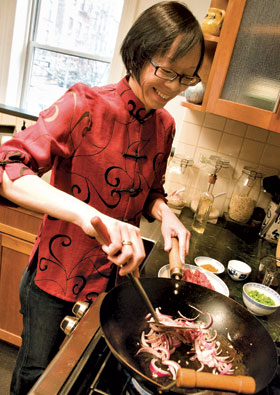This Sunday, the traditional Chinese New Year’s dragon dance will fill the streets of Manhattan’s Chinatown with performers and onlookers. The year of the dragon started this past Monday, and many families will continue to celebrate during the first two weeks of the Lunar New Year by eating auspicious foods and observing certain traditions. The practices are meant to bring prosperity, good fortune and togetherness.
Grace Young, a former test kitchen director and author of The Wisdom of the Chinese Kitchen, as well as Stir Frying to the Sky’s Edge, made a New Year’s Eve meal this year as a means of preserving her family’s culinary tradition. “[My mother is] too old to cook now, and she doesn’t even remember the dishes,” she explained, “so it’s sort of beautiful that I can give it back to her."
Young notes that dumplings and spring rolls are eaten during the Chinese New Year because the shapes of the foods resemble gold ingots. In addition, noodles symbolize longevity.
“One of the most popular dishes to make for the New Year’s Eve meal is a whole fish, because it symbolizes a proper beginning and end to the year,” she said. “And the word for fish sounds like the word for wishes coming true and abundance in Chinese.”
Most families also save some of the fish to eat the following day with the belief that it brings good fortune from one year into the next. 
Fruit like tangerines are also often eaten and displayed during the Lunar New Year because the Chinese name for the fruit is a homophone of the Chinese word for “gold.”
Young also notes that lettuce, or sang choy in Cantonese, sounds like rising prosperity. A classic preparation is to quickly stir-fry it in a very hot wok or pan.
“It cooks very, very quickly,” said Young. “One of the big tips when you’re stir-frying lettuce is you should dry the leaves first. A Chinese chef in a restaurant kitchen doesn’t have to do that ... because their stoves are much more powerful.”
Other more elaborate dishes will also grace many tables during this time. Seafood will play an important roll in celebration of the year of the dragon.
“The dragon is actually considered the king of the ocean,” Young explained. “So oftentimes the dragon is associated with the lobster, but lots of people will serve seafood dishes.”
The Year of the Dragon also holds special meaning on a larger scale.
“Of all the animals there are in Chinese horoscope, it is considered the most powerful and the most auspicious,” said Young, who explains that many people who take stock in the Chinese zodiac wait until the year of the dragon to get married, have babies, and start businesses. “That’s how powerful this year is.”
Below, try Young’s recipe for stir-fried garlic lettuce.
Stir-Fried Garlic Lettuce
by Grace Young
from The Wisdom of the Chinese Kitchen (Simon & Schuster 1999)
In Hong Kong, stir-fried iceberg is extremely popular, and only the Cantonese could make iceberg so delicious. The iceberg attains sweetness from the soy sauce, sesame oil, and rice wine, and only takes three minutes to stir-fry. Bok choy is also delicious stir-fried in this manner.
- 1 medium head iceberg lettuce
- 1 ½ teaspoons soy sauce
- 1 ½ teaspoons sesame oil
- 1 teaspoon Shao Hsing rice wine or dry sherry
- ¾ teaspoon sugar
- ¼ teaspoons ground white pepper
- 3 tablespoons peanut or vegetable oil
- 3 cloves garlic, smashed and peeled
- ¼ teaspoon salt
1. Core the iceberg and separate into leaves. Wash the lettuce in several changes of cold water, breaking the leaves in half. Drain thoroughly in a colander until dry to the touch.
2. In a small bowl, combine the soy sauce, sesame oil, rice wine, sugar, and pepper.
3. Heat a 14-inch flat-bottomed wok or skillet over high heat until a drop of water evaporates within 1 to 2 seconds. Add the vegetable oil and garlic, and stir-fry 10 seconds. Add the lettuce and stir-fry 1 minute. Add the salt and stir-fry another minute, or until the lettuce is just limp. Swirl in the sauce and stir-fry 1 more minute or until lettuce is just tender and still bright green. Serve immediately. Serves 4 as a vegetable side dish.